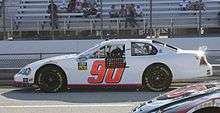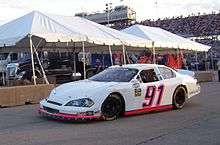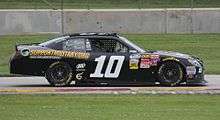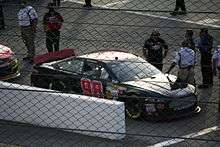Start and park

Start and park is a term used in auto racing, particularly in NASCAR-sanctioned races, to describe the practice of racing teams starting races but pulling the car off the track after just a few laps in order to collect prize money while avoiding expenses such as replacement tires, engine wear and tear, and hiring a pit crew.[1] The practice has existed due to the relatively high purse for even a back-of-the-pack finish, as well as the high costs of fielding a car for an entire race. While start-and-park entries occasionally act as "field fillers" a term typically used outside of NASCAR when a small amount of teams show up to a racetrack, the practice is criticized in instances when they take spots away from teams intending to run the full race.[2]
In some cases, a team will use a start-and-park car to help fund another competitive car in the same or a different series. This practice is prevalent in NASCAR's second-tier Xfinity Series, notably by The Motorsports Group, and TriStar Motorsports.[2][3][4] However, there are some cases in which a small underfunded team does use this money to eventually run full races, or conserve the car. Teams like NEMCO Motorsports, Leavine Family Racing, and Phil Parsons Racing have done this in the past, before transitioning to running full races.[5]
A visible increase in the presence of starting and parking in the 21st century has made it one of the more polarizing and controversial topics in the sport.[2][5] In 2013 and 2014, changes in the structuring of prize money awards and qualifying procedures made starting and parking less attractive, encouraging (or forcing) low-budget teams to run full races.[5][6][7]
Description

A start and park occurs when a race team pulls out of an event early on, rather than completing the full race, and will be credited with a did not finish (DNF). The practice is the result of the high costs of running full-length races including hiring a pit crew, as well as the high payout from simply starting a race. For example, at a June 2009 Cup Series race, Joe Nemechek earned $64,725 after finishing 41st in a start and park effort, while Dexter Bean ran the entire race to a 36th-place finish and earned only $725 more ($65,450).[1] New teams may start and park to gain funds, experience, and information to run future races competitively. Cup teams such as Germain Racing, Tommy Baldwin Racing, and Phil Parsons Racing have parked in many of their early starts, before finding sponsorship and success in later endeavors.[5]

Other times, teams will field one or multiple additional cars to earn money so their primary cars can run the full race. For example, since 2011, 2000 Busch Series Champion Jeff Green has start and parked in most of his starts for TriStar Motorsports, while the team's other cars (which often have some sponsorship) have run the full race. Green's entry, according to owner Mark Smith, acts as somewhat of an R&D car, and allows the team to field multiple full-time entries. Green had the most last place finishes in every year in the now Xfinity Series between 2011 and 2013 — a total of 37 last place finishes — and set the series record for career last place finishes in 2015 with 76.[4][8][9]
Identifying a start and park
When retiring from a race, a start and park team will usually list a mechanical failure as the reason for not finishing (transmission, electrical, overheating, suspension, etc...) as required by NASCAR.[2] Because of this, there is no official way to determine if a team intended to not finish without impounding the race car for a full inspection. This was done at a Sprint Cup race at Auto Club Speedway in 2010, where NASCAR impounded Prism Motorsports' 41st finishing No. 66 car driven by Dave Blaney after Blaney qualified fifth and led three laps before retiring with an "engine issue".[10] NASCAR currently does not keep start-and-park statistics.[5] A blog called LASTCAR on the other hand attempts to quantify last place finishes; the recipient of the most last-place finishes in each of the top three touring series is named Lastcar champion for the year. In 2013, Phil Parsons Racing driver Michael McDowell was crowned with a third consecutive "Lastcar Championship" for the Sprint Cup Series after earning eight last place finishes that year and 19 over the three-year period.[11]
Besides back of the pack finishes, another way to identify start and park teams is by monitoring the number of laps a team completes over the course of the season, or the percentage of each race the entry competes in. PPR and McDowell, for example, completed 34 percent of the laps possible during their 2013 season, while the team with new driver Josh Wise completed over 90 percent the next year.[5]
Field fillers
"Field filler" is a term describing teams and drivers that enter a race only when there are not enough entries to fill the full starting grid, thus guaranteeing the team a spot in the field. Frequently, these entries have no intention or capability of running competitively, either starting and parking or running the full race well below the pace of the leaders. The term is more commonly used in events outside of NASCAR, such as Formula One and IndyCar, and is occasionally used interchangeably with the term backmarker.[2][12][13]
Like start-and-parking, the practice in NASCAR has been the subject of criticism, mainly due to the safety issues of cars running well below reasonable speeds, or creating accidents that collect competitive drivers running for the championship.[12][14][15] NASCAR has also been accused of allowing noncompetitive entries into the race — or inviting the teams themselves — in order to fill the full 40-car starting grid (such as two 2004 incidents mentioned below).[12][14]
Early instances
In a couple of cases, a team that entered the season finale with the points lead entered additional cars in order to maximize their chances of clinching the season championship. The extra car would prevent the contender from finishing last and would provide a back-up car in case the primary car suffered a mechanical failure at the starting grid (or failed to qualify altogether). The additional entry could also serve as a blocker of competing drivers, or could drop to the back of the field to allow the primary car to gain positions and points sufficient to clinch the championship, although unsportsmanlike conduct was never officially used nor condoned.
1993
During the 1993 Hooters 500, the season finale, Dale Earnhardt, driving for Richard Childress Racing (RCR), entered the race with the championship lead. Mathematically, as long as Earnhardt did not finish worse than 34th, he would accumulate enough points to clinch the 1993 NASCAR Winston Cup Championship, his sixth title. RCR entered veteran Neil Bonnett in a second car (No. 31), and Bonnett qualified 35th as a team backup. The team arranged that Bonnett would step aside from the No. 31 car, in the last minute, in the event that Earnhardt's car, after pre-race inspection, suffered mechanical failure on the grid or during the pace laps. If Earnhardt started the race in the No 31 car, by rule, he would be awarded full points for that entry. Earnhardt started his primary car as expected, and Bonnett pulled off the track to finish last after five laps. The team gave the reason of "engine failure." Bonnett's intentional start and park helped maximize Earnhardt's finishing position, as only seven other cars had to drop out for Earnhardt to clinch the title. The No. 31 car would be later run as RCR's second full-time entry with Mike Skinner, Robby Gordon, Jeff Burton and Ryan Newman driving since 1995, while Lowe's, AT&T, and Caterpillar have been the sponsor since 1995.
1995
At the 1995 season finale, the NAPA 500, Hendrick Motorsports entered a fourth car just for this race just in case the unforeseen were to hit Jeff Gordon's car. If problems were to befall Gordon's car, the car would immediately pull off the track and retire from the race. This was the No. 58 Chevrolet with "Racing for a Reason" on the quarterpanels. Racing for a Reason referred to finding a cure for leukemia, a disease that owner Rick Hendrick had been diagnosed with. The team had originally hired Jimmy Horton to drive the car in the race. Horton qualified the car in 34th, but was unable to race it due to serious injuries suffered in a crash in the ARCA Bondo Mar-Hyde Series support race the day before the NAPA 500. Jeff Purvis was then hired to sub for Horton in the No. 58 and drove the car to a 26th-place finish, eight laps down. The former No. 58 car is now known as the No. 48 car driven by Jimmie Johnson with Lowe's sponsorship since 2002. The team won five straight Sprint Cup Championships between 2006 and 2010, a sixth in 2013, and a seventh in 2016.
2003
During the season finale of the Craftsman Truck Series at Homestead Miami Speedway, a three-way-battle for the championship was set up between Brendan Gaughan, Travis Kvapil, and Ted Musgrave. In an attempt to ensure victory, Musgrave's owner Jim Smith entered five trucks, all with sponsorship, to run the full race. Kvapil's IWX team also entered a second truck with former series champion Jack Sprague, and Gaughan's Orleans Racing entered a No. 61 truck for Scott Lynch. Smith's No. 7 truck driven by Tyler Walker was involved in several incidents, and would finish seven laps down. The most controversial result of the five Ultra Motorsports trucks occurred on lap 100 when Smith's No. 10 truck driven by Marty Houston spun exiting turn four, coming down the track and spinning out Gaughan, who was t-boned in the driver's side on the frontstretch by a third truck. The incident cost Gaughan the championship, eventually claimed by Kvapil after Musgrave was black flagged late in the running.[16]
Recent instances
2000s
In the mid-to-late 2000s the number of start and park teams had noticeably increased. Nationwide Series (now Xfinity Series) director Joe Balash stated that the growing purses available for competing were responsible for the increase, while drivers and car owners cited the state of the economy and costs of competing as the reason for the prevalence of the practice.[2][17] Among the most well-known examples was the Nationwide Series team MSRP Motorsports, which famously start and parked their unsponsored No. 90 and No. 91 cars in nearly all of their starts between 2008 and 2010.[2] They ran only two full races, at Watkins Glen in 2009 with Dave Blaney (this car only had a sponsor because another car carrying the sponsor failed to qualify), and at Road America in 2010 with Patrick Long driving the car.[18]
In 2004, Phoenix Racing, a team known for its prowess at Superspeedways, and veteran driver Joe Ruttman failed to hire a pit crew during the Subway 400 at Rockingham Speedway. NASCAR black flagged Ruttman's No. 09 Dodge for not having a pit crew, parking the car after only one lap. The team earned $54,196 for their efforts, but were referred to as "sort of a sham" by NASCAR vice-president Jim Hunter. It had been rumored, however, that NASCAR itself had contacted teams (including Phoenix) to fill the 43-car field after only 37 entries planned on running the race, an accusation the sanctioning body denied. Kirk Shelmerdine's No. 72 Ford was also black-flagged eight minutes into the race for not maintaining minimum speed on the one mile track, adding to the speculation. Although, Phoenix Racing owner James Finch vowed never to start-and-park again; the team would start-and-park again in the future.[1][19][20] Two races later at Darlington, Andy Hillenburg (one of the drivers believed to be a field filler at Rockingham) was spun by Tony Stewart and collected Jeff Gordon in the process, after Hillenburg was running well below the pace of the leaders.[12][14]
2009

In 2009, several Cup teams start-and-parked on a regular basis, including the No. 66 of Prism Motorsports (MSRP's Cup team), the No. 36 of rookie team Tommy Baldwin Racing, the No. 87 of Joe Nemechek's NEMCO Motorsports, Front Row Motorsports' No. 37, and the No. 71 of TRG Motorsports. While Prism and NEMCO ran almost exclusively start and park, TBR ran some full races when funding and resources were available. Front Row's No. 37 car was run to support their full-time No. 34 car ran by John Andretti, with both cars advertising owner Bob Jenkins' Taco Bell and Long John Silvers franchises. TRG meanwhile would run full-races with 2000 Cup champion Bobby Labonte and sponsor Taxslayer, while parking with David Gilliland when there was no sponsor. Phoenix Racing, which had sponsorship from Miccosukee Resort and Gaming, ran full races in Hendrick Chevys for Brad Keselowski (10 races) and Ron Fellows (two races), while often parking in Dodges with veterans Sterling Marlin and Mike Bliss. Fellows ran competitively during his road course races, and Keselowski scored his and Finch's first victory at Talladega. Aric Almirola ran the full race at Loudon, finishing 29th in a Dodge.
During the first twelve races of the 2009 NASCAR Sprint Cup season, Blaney, the driver of Prism's No. 66 Toyota, earned over $1.1 million after completing only two of the races and 21% of all possible laps.[1] At the June 2009 Camping World Truck Series race at Texas, 10 of the 33 entrants parked their trucks by the end of lap 26.[21]
2010–2013

On Saturday, March 19, 2011, before the start of the NASCAR Nationwide race at Bristol Motor Speedway, driver Jennifer Jo Cobb refused to start and walked away from the No. 79 2nd Chance Motorsports car when she allegedly was instructed less than ten minutes prior to the race by car owner Rick Russell to start and park rather than race to completion, and that the team would be replacing her the following week. Russell's argument was that their secondary car was heavily damaged the previous week at Las Vegas. Cobb said that she had agreed to race carefully to completion to preserve the car for future races, but objected to Russell telling her to start and park, especially in light of her racing contract that required her to pay for tires and engines. The team replaced her with Chris Lawson, who ran four laps before parking the car. Cobb is the first driver to publicly refuse to start a race when instructed to start and park.[22][23]
In 2013, NASCAR reduced the size of the Nationwide Series starting grid from 43 cars (then the size of a Cup Series field) to 40 cars.[6] In 2013 and 2014, the sport restructured the prize money structures of its national series, and eliminated the top 35 rule which previously guaranteed the top 35 teams in terms of owners' points a spot in the field. Start and parks became more limited in 2013 but still appeared on a weekly basis.
2014
In 2014, start and parking was mostly nonexistent in the Sprint Cup Series, with even former parker Phil Parsons Racing (the successor to MSRP and Prism) implementing measures and making partnerships to run full races.[5][7] Only one car practiced start and park in 2014, the No. 93 BK Racing Toyota, part of a team that fields three other cars that run the full distances. The 93 was mainly entered when there were fewer than 43 entries just to bring the field to 43 cars.
2015
In 2015, no teams in the Cup Series ran a start and park team in a points race. The only instance of start and park during the season came at the Sprint Showdown at Charlotte Motor Speedway. After completing just 18 of the 40 laps, Mike Bliss took his unsponsored No. 32 FAS Lane Racing car behind the wall with a reported vibration. On lap 20, Landon Cassill and his No. 40 Hillman-Circle Sport LLC Chevy exited the race claiming engine troubles. At the same time, the No. 7 Tommy Baldwin Racing entry of Alex Bowman withdrew from the race citing electrical issues.
2016
For the 2016 season, NASCAR implemented a charter system, under which 36 specified teams were granted "charters" giving them guaranteed placement in all Sprint Cup Series races. At the same time, the race field was reduced from 43 to 40. As teams must have competed in the Sprint Cup full-time for the past three consecutive seasons in order to have acquired a charter, teams can be forced to sell their charters if they finish in the bottom three of the owners' standings for three seasons in a row, and only up to four positions are available to non-chartered teams, this system primarily rewards established teams that have committed to participate across the entire season. These changes, as well as a reduced fixed purse for non-chartered teams, effectively reduces the viability of start and park strategies.[24][25][26]
References
- 1 2 3 4 Bowles, Tom (June 11, 2009). "As NASCAR money gap widens, start and parkers soldier on". Sports Illustrated. Archived from the original on 2012-10-25. Retrieved October 2, 2009.
- 1 2 3 4 5 6 7 Zeller, Bob (February 2009). "The Quitting Game". Car and Driver. Car and Driver. Retrieved October 5, 2014.
- ↑ DeGroot, Nick (September 16, 2014). "The Motorsports Group planning full-time Sprint Cup effort for 2015". motorsport.com. Retrieved October 5, 2014.
- 1 2 Gray, Nick (June 26, 2014). "Team comes first for Kentuckian Green as 'start-and-park' driver in NASCAR". Kentucky.com. Lexington Herald-Leader. Retrieved October 5, 2014.
- 1 2 3 4 5 6 7 Cavana, Alan (April 29, 2014). "Smaller teams saying no to 'start and park'". NASCAR.com. Retrieved April 30, 2014.
- 1 2 Newton, Dave (October 16, 2012). "Nationwide field to shrink in 2013". Charlotte, North Carolina: ESPN. Retrieved October 5, 2014.
- 1 2 Smith, Steven Cole (April 15, 2013). "NASCAR doing better job of curbing start-and-park drivers". Autoweek. Retrieved October 5, 2014.
- ↑ Beard, Brock (August 30, 2010). "N'WIDE: Past LASTCAR Champions". brockbeard.blogspot.com. Blogspot. Retrieved August 13, 2014.
- ↑ Beard, Brock (September 12, 2015). "XFINITY: Jeff Green Sets New NASCAR Single-Season Last-Place Record". LASTCAR.info. Retrieved 14 September 2015.
- ↑ Newton, Dave (February 22, 2010). "Parsons doesn't blame NASCAR for seizing the 66". ESPN David Newton Blog. Charlotte, North Carolina: ESPN. Retrieved September 10, 2014.
- ↑ Beard, Brock (August 30, 2010). "CUP: Past LASTCAR Champions". brockbeard.blogspot.com. Blogspot. Retrieved August 13, 2014.
- 1 2 3 4 Turner, Charlie (January 30, 2009). "How To Fix NASCAR: 5. Field-Filler Frenzy". Bleacher Report. Bleacher Report, Bench Racing Productions, LLC. Retrieved 18 March 2015.
- ↑ Buchanan, Mary Jo (August 27, 2010). "Kirk Shelmerdine's Fire Sale Symbolic of Death of NASCAR Independents". bleacherreport.com. Bleacher Report. Retrieved 6 June 2015.
- 1 2 3 "NASCAR » Gordon questions 'field filler' role after shunt.". Crash.net. Crash Media Group. March 2004. Retrieved 18 March 2015.
- ↑ Ryan, Nate (July 14, 2014). "Jeff Gordon says NASCAR should rethink minimum speeds". USA Today. USA Today. Retrieved 18 March 2015.
- ↑ "Early wreck, lost chance won't get Gaughan down". Las Vegas Sun. November 17, 2003. Retrieved October 5, 2014.
- ↑ Bernstein, Viv (February 15, 2009). "Economy Catches Up to Nascar's Big Names". The New York Times. Retrieved May 24, 2010.
- ↑ D'Hondt Humphrey Motorsports (June 15, 2010). "D'Hondt Humphrey names Pat Long for Road America". motorsport.com. Denver, North Carolina. Retrieved October 5, 2014.
- ↑ Fryer, Jenna (February 24, 2004). "NASCAR calls Ruttman run 'a sham'". ESPN Sprint Cup. Concord, North Carolina: ESPN, Associated Press. Retrieved October 5, 2014.
- ↑ Fryer, Jenna (February 22, 2004). "Rockingham field filled with slow competition". The Cincinnati Enquirer. Rockingham, North Carolina. Associated Press. Retrieved October 5, 2014.
- ↑ Racing-Reference.info – 2009 Winstar World Casino 400
- ↑ Broomberg, Nick (March 19, 2011). "Jennifer Jo Cobb refuses to start-and-park, quits before race". Yahoo!. Retrieved October 5, 2014.
- ↑ Long, Dustin (March 19, 2011). "Driver refuses to start Nationwide race after she says that owner ordered her to start and park". PilotOnline.com. The Virginian-Pilot. Retrieved October 5, 2014.
- ↑ "NASCAR unveils charter system for Sprint Cup Series team owners". SB Nation. Retrieved 28 February 2016.
- ↑ Palmer, Tod (February 9, 2016). "NASCAR introduces charter system, announces sweeping changes to business model". The Kansas City Star. The McClatchy Company. Retrieved February 9, 2016.
- ↑ "Field of 39 cars at Atlanta smallest in nearly 20 years". ESPN.com. Retrieved 28 February 2016.